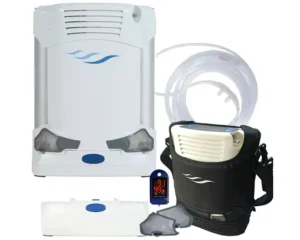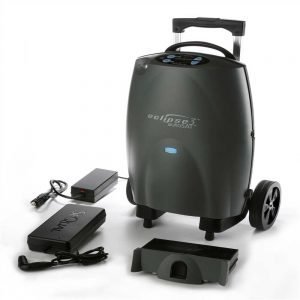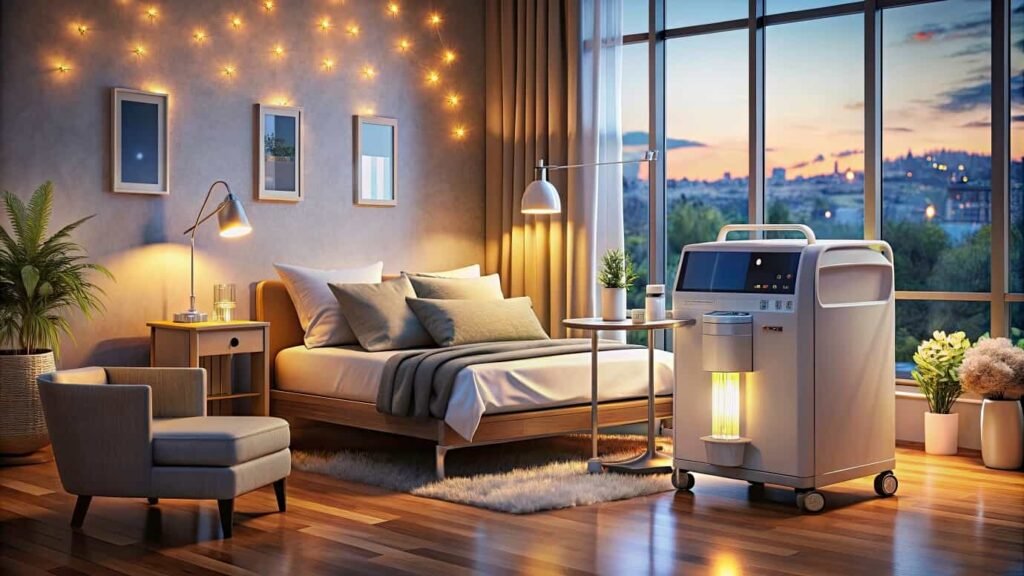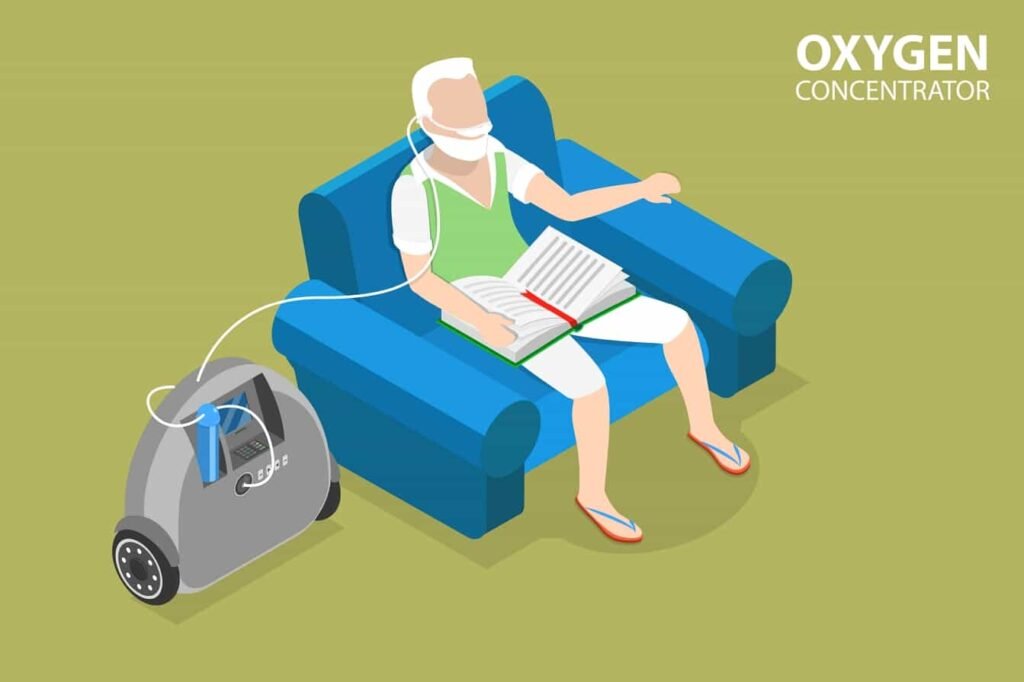Thousands of Americans need oxygen support to feel their best each day. But just because you need oxygen support doesn’t mean you can’t lead an active lifestyle.
Portable oxygen concentrators are lightweight, battery-operated devices that offer increased oxygen saturation without the hassle of bulky oxygen canisters. They allow you to get the oxygen support you need at home or on the go. Keep reading our portable oxygen concentrator buying guide to learn more!
What Is a Portable Oxygen Concentrator?
Oxygen concentrators are medical devices used for oxygen therapy. Doctors prescribe them for people with respiratory conditions that make breathing difficult. The devices work by purifying the ambient air to give people a higher concentration of oxygen with every breath.
Air typically contains about 78% oxygen, 22% nitrogen, and other gases. Oxygen concentrators filter out the nitrogen and channel 90% to 95% pure oxygen through a mask or nasal cannula. When you use a concentrator, you usually breathe. Your lungs do not have to work as hard to send oxygen to your body.
Oxygen concentrators clean the air around you, so you do not need to replace oxygen tanks often. Portable oxygen concentrators are light and easy to carry, making them great for use outside the home or while traveling.
Who Needs a Portable Oxygen Concentrator?
Oxygen concentrators are medical devices prescribed by a doctor. They can be used for long-term breathing support or a shorter period, such as while recovering from an illness or injury.
Portable oxygen concentrators are helpful for people with a variety of respiratory conditions, including:
- Asthma
- Bronchitis
- Chronic obstructive pulmonary disease (COPD).
- Cystic fibrosis
- Emphysema
- Heart failure
- Injury (rib fracture, collapsed lung, bruised lung)
- Lung cancer
- Pneumonia
- Sleep apnea
Key Features to Consider When Buying a Portable Oxygen Concentrator
When picking a portable oxygen concentrator, the first features you will consider are size and weight. It is essential to choose a model you can lift and carry easily. In addition to basic convenience, you should consider functions such as airflow and battery life.
Flow Type
There are two different flow options. Continuous flow concentrators provide a constant stream of oxygen whenever you turn on the device. Pulse dose concentrators deliver a short burst of oxygen when the user inhales, but don’t emit oxygen continually. Your doctor can tell you which type of oxygen flow is best for your needs.
Flow rate
The flow rate refers to the amount of oxygen the device puts out. Flow is measured in liters per minute.
Depending on the device, the flow rate can range from 3 to 10 LPM, and most offer adjustable flow rates. Choosing a device that can produce a higher flow rate than you typically need is best. For example, if your usual flow rate is 5 LPM, choose a device that goes up to 8 LPM. This way, you can increase it if you need a higher flow rate.
Power source
Portable oxygen concentrators run on batteries. Most devices use rechargeable batteries. These batteries let the device run for 3 to over 12 hours.
Larger batteries last longer but add to the device’s size and weight. We strongly advise carrying an extra backup battery, particularly for airline travel. The FAA says travelers using oxygen concentrators must have enough battery power. The battery should last twice the flight time.
Oxygen concentration
Oxygen concentrators can deliver different oxygen concentrations, usually between 87% and 99%. The top concentration level depends on the concentrator’s size, design, and filtration system. Your doctor will tell you what concentration you need. People with chronic respiratory issues often require higher oxygen concentration levels than those with a short-term condition.
Noise level
Any mechanical device is going to make some noise. Oxygen concentrators are relatively quiet, but they will make noise when they are running. Listening to the device before buying it is helpful to understand how loud it is. Ensure you can sleep with it on and that the noise doesn’t make normal conversation difficult.
Expert Recommendations: Best Portable Oxygen Concentrators
When selecting a portable oxygen concentrator, you have many options. These models offer customizable oxygen flow and concentration, strong battery life, and exceptional portability.
1. CAIRE FreeStyle Comfort ($1,395.00)
The Freestyle Comfort is one of the best portable oxygen concentrators. It offers excellent features and is easy to carry.
This pulse flow device has five settings. It can deliver up to 1050 mL of oxygen per minute and is up to 95% pure to ensure proper saturation.

CAIRE’s UltraSense technology guides the pulse flow. The compressor changes the device’s oxygen supply to fit your breathing rate. It works whether you are awake, asleep, or exercising.
2. Inogen One G5 ($1,695.00)
The Inogen One G5 is designed for 24/7 oxygen delivery. It has six varying flow settings and 1,260 mL of oxygen output per minute. Bluetooth-enabled, it features easy-to-read LCDs and simple control functions. Inogen’s Intelligent Delivery Technology matches your breathing rate and increases each oxygen bolus dose as breathing slows during sleep.

The Inogen One G5 shows Inogen’s commitment to innovation. Its design targets oxygen therapy users and considers the needs of homecare providers.
Like the Inogen One G4, the Inogen One G5 is Bluetooth-enabled and can be used with the Inogen Connect App.
3. Inogen Rove 6 Portable Oxygen Concentrator
The Inogen Rove 6 is a small but powerful portable oxygen concentrator weighing under five pounds. Even at that small size, it provides medical-grade oxygen. It can deliver up to 1,260 milliliters per minute with 6 adjustable pulse flow settings. The standard battery lasts up to 6 hours, and the extended battery lasts up to 12 hours.
The Rove 6 is Bluetooth-enabled and works with the free Inogen Connect mobile app.
4. Respironics SimplyGo Portable Concentrator
The Respironics SimplyGo Portable Concentrator delivers both pulse dose and continuous flow. It offers up to 2 LPM of constant flow and a six-setting pulse dose output option. The Sleep Mode setting increases oxygen output during nighttime, and an oxygen delivery trigger rises with a soft pulse.
Only 10 pounds, the Simply Go has a wheeled design for easy maneuverability. It also includes alerts for high breathing rate, low oxygen, system problems, and low battery.
5. CAIRE SeQual Eclipse 5 ($1,550.00)
The SeQual Eclipse 5 mobile unit weighs 18 lbs, making it heavier. However, the extra weight is worth it for its features.

Its continuous flow dose ranges from 0.5 to 3 LPM in increments of 0.5 for an exact dosage. Pulse doses range from 16 to 192 mL across nine settings, with an average purity of around 90%. The Eclipse 5 uses SeQual’s AutoSAT technology to maintain the same amount of oxygen consistently.
6. OxLife Independence Oxygen Concentrator
O2 Concepts Oxlife Independence is 16.7 lbs and has built-in wheels for easy portability. It offers a continuous flow of up to 3 liters per minute and a pulse dose of 0.5 to 5 liters per minute. The battery lasts close to 6 hours and comes with a battery life indicator and a built-in low 02 sensor. It is compatible with CPAP/BiPAP machines and offers flexibility for people with multiple oxygen needs.
| CAIRE FreeStyle Comfort | Inogen One G5 | Inogen Rove 6 Portable Oxygen Concentrator | Respironics SimplyGo Portable Concentrator | CAIRE SeQual Eclipse 5 | OxLife Independence Oxygen Concentrator |
| Noise level: 38 decibels
Battery life: Up to 13 hours with extended battery Flow type: Pulse, five adjustable settings FAA approved: Yes Weight: 5lbs |
Noise: 39 decibels
Battery life: Up to 13 hours with extended battery Flow type: Pulse, six adjustable settings FAA approved: Yes Weight: 4.7lbs |
Noise level: 37 decibels
Battery life: Up to 13 hours with standard and extended battery Flow Type: Pulse, six adjustable settings FAA approved: yes Weight: 4.7lbs |
Noise level: 43 decibels
Battery life: Up to 4.6 hours Flow Type: Continuous and pulse FAA approved: yes Weight: 10lbs |
Noise level: 48 decibels
Battery life: Up to 4.4 hours Flow Type : Pulse FAA approved : Yes Weight: 18lbs |
Noise level: Quiet operation
Battery life: Up to 5 hours Flow Type: Continuous and Pulse, six adjustable settings FAA approved: Yes Weight: 10lbs |
How to Choose the Right Portable Oxygen Concentrator for Your Needs
When you choose a portable oxygen concentrator, your first consideration should be your medical requirements. Talk to your doctor about your best oxygen concentration and flow pattern level. Look for devices that meet your medical needs so you don’t risk compromising your respiratory function.
You should also consider your lifestyle. You will want a portable oxygen concentrator that works for how and where you plan to use it.
If you live an active lifestyle, look for a lightweight, easy-to-carry model. If you like to travel, ensure your device meets FAA rules and has enough battery for your flights.
Cost considerations are another factor that can affect your choice of oxygen concentrator. Talk to your insurance provider and determine their coverage for portable oxygen therapy devices. Choosing a covered device can significantly decrease your out-of-pocket costs.
Most devices have a warranty guaranteeing proper operation for several years after purchase. Check the warranty details and register the device to take advantage of repair and replacement services. In addition, ask about customer service options. Learn in advance if the device maker offers phone support or online chat if you have problems or questions about your device.
Contact Marcroft Medical today to learn more about our selection of portable oxygen concentrators. Our skilled team members will gladly answer your questions and help you choose the best device. You can count on Marcroft Medical for excellent customer support before and after purchasing.






